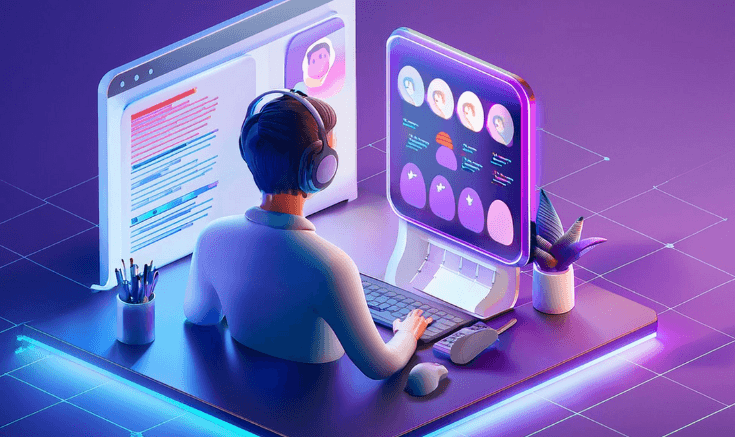

10 use cases of NLP in customer service
JAN. 25, 2025
6 Min Read
Natural language processing (NLP) is reshaping customer service, making it faster, more accurate, and scalable than ever before.
Businesses are using NLP technologies to address long-standing customer service challenges, from reducing response times to providing tailored support at scale. Automating key processes and improving engagement gives NLP the ability to equip organizations to meet customer expectations while streamlining workflows and minimizing operational costs.
Key takeaways
- 1. NLP enhances customer service by automating processes like ticket classification, chatbots, and sentiment analysis, reducing response times and costs.
- 2. Multilingual support powered by NLP expands global reach and eliminates language barriers, providing inclusive support without increasing staffing needs.
- 3. Predictive customer service tools use NLP to anticipate and address potential customer issues before they arise, boosting satisfaction and loyalty.
- 4. Speech recognition systems and personalized recommendations powered by NLP improve accessibility and create more engaging customer experiences.
- 5. Overcoming challenges like data quality, integration, and privacy is key to successfully implementing NLP and unlocking its full potential.
Understanding NLP in customer service
Natural language processing is a branch of artificial intelligence that helps machines interpret and respond to human language effectively. Within customer service, it bridges the gap between automation and meaningful interaction, allowing businesses to provide timely, relevant support. NLP analyzes customer queries, speech, and text data to identify patterns and deliver actionable insights.
Businesses rely on NLP in customer service to tackle challenges such as managing large volumes of inquiries, offering multilingual support, and maintaining response quality. Tools like chatbots, sentiment analysis, and automated workflows streamline customer interactions while reducing operational costs. These technologies help companies achieve scalability, optimize processes, and meet customer expectations without overwhelming human resources.
“Natural language processing has become an essential tool for modern customer service teams, addressing critical challenges like scaling operations and improving response accuracy.”
Benefits of NLP in customer service
Natural language processing offers a transformative approach to customer service by automating processes, improving response accuracy, and driving efficiency across operations. As businesses face mounting pressures to reduce costs and deliver exceptional experiences, NLP provides a scalable solution that supports growth without sacrificing quality. Whether handling routine queries or offering personalized support, NLP empowers companies to meet customer expectations quickly and precisely. These tools also help organizations reveal new areas for efficiency, improving the customer experience and internal workflows.
- Improved response times: NLP-powered systems process customer inquiries immediately, reducing delays and allowing for faster resolutions. This ability to deliver timely support creates stronger customer relationships and improves overall satisfaction.
- Cost efficiency: Automating routine customer service tasks reduces dependency on large teams, lowering operational expenses while maintaining high performance. Companies can allocate resources more effectively, addressing complex needs and focusing on strategic initiatives.
- 24/7 availability: Chatbots and virtual assistants powered with NLP operate around the clock, offering seamless support without additional staffing. Customers benefit from reliable help whenever they need it, regardless of time zones or business hours.
- Personalized interactions: NLP tools analyze customer preferences and past interactions to deliver tailored responses and recommendations. This personalization fosters engagement and builds long-term loyalty with customers.
- Enhanced scalability: NLP solutions allow businesses to handle higher volumes of inquiries as operations grow without expanding staff proportionally. This scalability ensures efficient service delivery even during periods of increased need.
- Consistency in support: NLP delivers accurate and consistent responses across all interactions, reducing errors that could harm the customer experience. This reliability builds trust and demonstrates a commitment to service quality.
- Multilingual capabilities: NLP makes it possible to communicate with customers in multiple languages, simplifying global support and helping businesses serve international markets effectively.
The measurable impact of NLP extends far beyond automation. These tools directly contribute to better outcomes, including faster service delivery, reduced costs, and improved scalability. Businesses can create future-ready strategies, streamline operations, and deliver customer experiences that drive loyalty and growth. NLP empowers organizations to stay agile and aligned with customer needs, ensuring they remain a step ahead in providing meaningful and efficient support.
10 use cases of NLP in customer service
Natural language processing has become essential for modern customer service teams, addressing critical challenges like scaling operations, improving response accuracy, and delivering cost-effective solutions. These technologies empower businesses to streamline workflows and optimize customer engagement, aligning with goals like time to value, cost efficiency, and measurable results. Businesses that adopt NLP in customer service can unlock untapped opportunities to reduce operational burdens and improve customer satisfaction through more intelligent automation and deeper personalization.
The applications of NLP in customer service extend beyond simple task management to include innovative strategies for creating personalized, scalable, and efficient service. From automating routine tasks to delivering tailored experiences, NLP tools are designed to reduce operational strain while delivering more excellent value to customers and organizations.
1. Chatbots and virtual assistants

Chatbots and virtual assistants powered with NLP provide instant, conversational support to customers. These tools handle common inquiries, resolve simple issues, and escalate more complex situations when necessary.
Natural language processing helps chatbots interpret customer intent accurately, creating smoother and more human-like interactions. Chatbots allow businesses to handle inquiries around the clock while lowering response times and costs. These systems are critical to scaling customer service without sacrificing quality.
2. Sentiment analysis

Sentiment analysis identifies the emotional tone of customer communications, such as emails or live chat messages. This process allows businesses to prioritize dissatisfied customers and act quickly to improve their experience.
Sentiment analysis helps support teams categorize customer feedback into actionable insights, revealing trends that can inform strategic improvements. Companies can resolve issues more effectively and increase satisfaction by addressing negative sentiments as they arise.
3. Automated ticket classification
Automated ticket classification analyzes and routes customer inquiries based on their intent and content. NLP permits this technology to assign tickets to the right teams or agents, reducing manual effort and improving accuracy.
Automation eliminates the delays and errors often associated with human sorting of tickets, ensuring faster resolutions. This improvement not only enhances customer experience but also increases support teams' productivity.
4. Multilingual support

NLP tools for multilingual support allow businesses to communicate effectively with global audiences. These tools analyze and translate customer queries in real time, bridging language barriers without the need for additional staffing.
Expanding into international markets becomes more efficient when companies adopt multilingual NLP solutions.
5. Speech recognition systems
Speech recognition systems convert spoken words into text, allowing businesses to process customer inquiries through voice interactions. NLP enhances these tools to deliver precise responses in real time.
Voice-based services improve accessibility and cater to customers who prefer verbal communication over text-based channels. Businesses can reduce friction in their support processes and increase satisfaction by offering reliable voice interaction options.
6. Personalized recommendations
NLP tools analyze customer data to deliver personalized recommendations, such as tailored product suggestions or targeted solutions. This approach deepens engagement and aligns with customer preferences more effectively.
Delivering personalized recommendations enhances the customer experience and increases opportunities for cross-selling and upselling. Businesses can drive additional revenue and build loyalty by making interactions more relevant.
7. Email automation
Email automation tools powered by NLP process and respond to customer emails with minimal human intervention. These tools identify intent, generate accurate replies, and escalate more complex issues to agents when needed.
Automating email communication reduces response times and allows teams to focus on more critical tasks. Customers benefit from faster, more reliable interactions while businesses streamline their workflows and reduce costs.
8. Knowledge management systems

Knowledge management systems use NLP to make information easily accessible to customers and agents. These tools recommend relevant solutions based on customer queries, improving service efficiency and accuracy.
Empowering customers with self-service options reduces support ticket volumes and improves resolution times. Effective knowledge management helps agents resolve inquiries more quickly, enhancing productivity.
9. Predictive customer service

Predictive customer service anticipates customer needs and offers proactive solutions. NLP analyzes historical data and behavior patterns to identify potential issues before they arise.
Proactive notifications, such as alerts for potential delays or service disruptions, reduce the likelihood of customer frustration. Businesses that use predictive tools can improve satisfaction and strengthen trust while reducing the burden on their support teams.
10. Real-time alerts and notifications
Real-time alerts and notifications powered by NLP provide timely updates to customers regarding account activity, service changes, or delivery statuses. These tools interpret data to create relevant, actionable alerts for individual users.
Keeping customers informed with up-to-date information builds trust and improves their overall experience. Real-time notifications also reduce the number of inquiries sent to customer service, allowing teams to focus on resolving more complex issues.
NLP creates opportunities for businesses to scale their customer service operations while maintaining quality and delivering measurable results. These tools enhance service efficiency, support personalization, and improve operational workflows, helping organizations align with customer expectations and long-term business goals. Each use case demonstrates how NLP offers practical and impactful solutions for modern customer service needs.
“Predictive customer service uses NLP to anticipate customer needs and offer proactive solutions, minimizing disruptions and strengthening trust.”
Challenges of NLP in customer service
While natural language processing offers significant advantages in customer service, implementing these technologies comes with challenges. Addressing these obstacles requires careful planning and a clear strategy to achieve successful outcomes.
- Language complexity: Human language is inherently nuanced, making it difficult for NLP models to understand context, sarcasm, slang, or regional variations. Misinterpreting customer intent can lead to ineffective responses, which may negatively impact the customer experience.
- Data quality and volume: NLP systems use large datasets to train their models effectively. Poor quality or insufficient data can compromise the accuracy of these systems, limiting their ability to understand and respond to customer queries effectively.
- Integration with existing systems: Incorporating NLP solutions into legacy or existing customer service workflows can be technically challenging. Compatibility issues may arise, requiring significant time and resources to overcome.
- Privacy and compliance concerns: Processing sensitive customer information through NLP systems must comply with data protection regulations such as GDPR or CCPA. Ensuring robust security measures and maintaining customer trust are ongoing challenges.
- Cost of implementation: Deploying NLP systems can be resource-intensive, particularly for smaller businesses with limited budgets. The expense of acquiring technology, training models, and maintaining infrastructure may pose barriers to adoption.
- Progressing customer expectations: NLP systems must be continuously updated to adapt to shifting customer behaviors and preferences. Keeping models relevant and accurate requires ongoing effort and investment.
Understanding these challenges is critical for businesses adopting NLP in customer service. Companies that invest in high-quality data, robust integration plans, and compliance measures can address these obstacles and unlock the full potential of NLP technologies. With the right strategies, organizations can overcome barriers and deliver measurable improvements in customer experience and operational efficiency.
Implementing strategies for NLP in customer service
Successfully implementing natural language processing in customer service requires a structured approach that balances technical expertise with a focus on measurable business outcomes. Organizations can achieve significant improvements by following key strategies that align NLP initiatives with their broader operational goals.
Identifying clear objectives is the first step in designing an effective NLP strategy. Whether improving response times, reducing costs, or providing multilingual support, aligning NLP applications with specific goals ensures they deliver meaningful results. Prioritizing use cases that address pain points, such as automating ticket classification or offering real-time notifications, helps maximize value.
Building high-quality datasets is another critical component of implementation. Training NLP models requires clean, varied, and contextually relevant data. Investing in data collection and refinement ensures that systems perform accurately and adapt effectively to customer needs. Establishing robust feedback loops enhances performance, allowing the system to learn and improve.
Seamless integration with existing customer service workflows is essential for maximizing impact. Collaborating with IT teams to address compatibility issues ensures that NLP tools operate efficiently within the current infrastructure. Organizations can streamline this process by selecting scalable technologies that adapt to growing business requirements.
Ongoing monitoring and maintenance play a key role in sustaining the effectiveness of NLP systems. Regular updates to models, including incorporating new customer data and adapting to varying preferences, keep tools relevant and aligned with customer expectations. Adopting a continuous improvement mindset ensures long-term value.
Organizations that adopt these strategies can unlock the full potential of NLP in customer service, achieving measurable improvements in efficiency, customer satisfaction, and scalability. With a clear focus on objectives, quality data, and seamless integration, businesses can deliver innovative solutions that meet the requirements of modern customer service.
Natural language processing delivers more than automation—it unlocks opportunities for businesses to enhance customer experiences, improve scalability, and achieve measurable results. NLP is vital in aligning customer service strategies with business goals, creating pathways to innovation and operational excellence. At Lumenalta, we specialize in developing tailored NLP solutions that support your goals while ensuring seamless integration. Let’s build more innovative, more impactful customer experiences together.
Table of contents
- Understanding NLP in customer service
- Benefits of NLP in customer service
- 10 use cases of NLP in customer service
- 1. Chatbots and virtual assistants
- 2. Sentiment analysis
- 3. Automated ticket classification
- 4. Multilingual support
- 5. Speech recognition systems
- 6. Personalized recommendations
- 7. Email automation
- 8. Knowledge management systems
- 9. Predictive customer service
- 10. Real-time alerts and notifications
- Challenges of NLP in customer service
- Implementing strategies for NLP in customer service
- Common questions about NLP in customer service
Common questions about NLP in customer service
How does NLP improve customer service efficiency?
What are the challenges businesses face with NLP in customer service?
Can NLP help businesses offer multilingual support?
Is NLP suitable for small businesses with limited budgets?
How does NLP handle customer sentiment analysis?
Want to learn how NLP can bring more transparency and trust to your operations?









